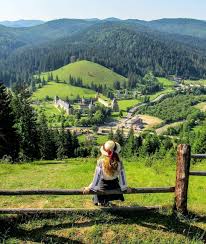Easter week in Romania is traditionally an opportunity for a short holiday as parents are taking advantage of their children’s vacation and employees are capitalizing on the long weekend. But where to go? We asked ChatGPT what the best Romanian and European Easter destinations are.
Acting like a travel agent, the AI chatbot gave us a top 3: 1) Maramureș: Known for its wooden churches and traditional villages, Maramureș offers a picturesque setting to experience authentic Romanian Easter celebrations, writes eToro analyst for Romania, Bogdan Maioreanu. Visit the Barsana Monastery and the Merry Cemetery in Săpânța. 2) Bucovina: This region is famous for its painted monasteries, which are UNESCO World Heritage sites. 3) Brașov: Located in the heart of the Carpathian Mountains, Brașov is a charming city with a rich history. Visit the Black Church, Council Square, and enjoy the stunning views from Tampa Mountain or the nearby, the medieval Bran Castle, often associated with Dracula..
ChatGPT also offered a comprehensive list of popular Easter destinations in Europe that include Vatican City in Italy, Seville in Spain, Braga in Portugal, Corfu in Greece and Krakow in Poland. But the AI’s international recommendations were a bit far from the top actual hotel searches for short stays (3-4 days) which listed Paris, London, Amsterdam, Rome, Barcelona, Madrid and Berlin as favourite destinations.
Now, that being said, we took a more in-depth look at the health of the tourism sector, with the warmer holiday season traditionally making its debut on Easter. Preliminary data are showing that despite inflation, strikes and travel disruptions, Europeans are booking more Easter trips than a year ago, according to the platform Sojern. As a whole, outbound travel from European countries is looking optimistic, with 80% of the origin markets displaying an increase in Easter travel demand at least a month in advance of the travel period when compared to 2022. Travelers originating in Portugal and the United Kingdom showed a keen interest in planning Easter breaks in advance of the holiday, with year-over-year increases in bookings of 60% and 49% respectively. At the other end of the spectrum, travelers from France and Switzerland were more hesitant to book ahead of time, with decreases in bookings of 32% and 10% respectively, compared to 2022.
According to the European Travel Commission, the travel industry will continue its recovery in 2023 but it needs the return of long-haul tourists to sustain it. Travel from the US to Europe is expected to grow, reaching over 80% of pre-pandemic levels in 2023, with a full rebound expected in 2024. A gradual recovery is likely from China too. Forward data on bookings shows that Chinese travelers still favor domestic travel. In 2023, travel from China to European destinations is projected to remain 60%-70% below pre-pandemic levels.
In Europe, not all regions are projected to recover their inbound tourism at the same pace. Looking at last year’s data, the slowest destinations to recover were in Eastern Europe due to the war in Ukraine and lack of Russian visitors to destinations heavily reliant on this market. The sharpest declines were observed in Finland (-38%), Lithuania, Latvia, and Romania (all -42%). Latest Romanian data for February 2023 is showing that the recovery continues, with the number of overnight stays being 32% higher than last year.

















